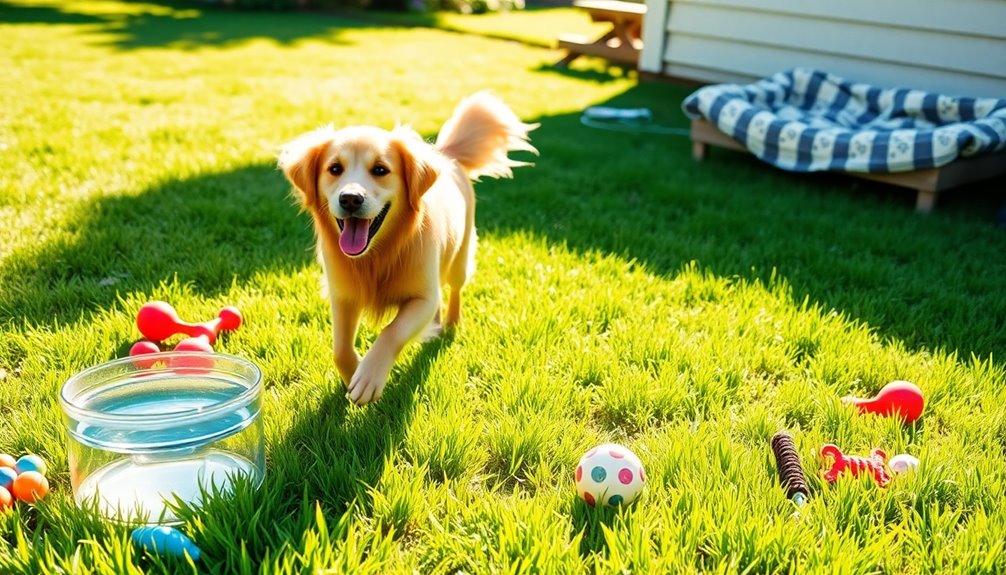To keep your dog happy and healthy all year, follow this seasonal care checklist. Adjust their diet based on age and activity, incorporating fresh fruits in summer and higher calories in winter. Tailor exercise routines: take long walks in spring, avoid heat in summer, enjoy outdoor play in fall, and keep winter activities short. Regular grooming prevents matting, while mental stimulation keeps boredom at bay. Don't forget routine vet check-ups and vaccinations to spot health issues early. Finally, make sure your home is safe and ready for emergencies. There's much more to explore to keep your furry friend thriving!
Key Takeaways
- Adjust your dog's diet seasonally to meet changing nutritional needs, incorporating fresh fruits and vegetables in summer while increasing calories in winter.
- Modify exercise routines based on weather; prioritize longer walks in spring, early outings in summer, and indoor play during winter.
- Maintain regular grooming practices, including brushing, bathing, and nail trimming, to ensure cleanliness and prevent health issues.
- Schedule routine vet checkups and vaccinations to monitor health, weight, and dental conditions, ensuring your dog is protected against diseases.
- Prepare an emergency kit with food, water, and first aid supplies, and establish an emergency plan for safe evacuation if necessary.
Proper Nutrition Year-Round

Proper nutrition is vital for your dog's health throughout the year. As a pet owner, you need to tailor your dog's diet based on their age, breed, and activity level.
Puppies aged 8-12 weeks should eat four meals a day, while adult dogs generally do well on one or two meals, depending on their size and specific needs.
Incorporating high-quality, premium dry food into your dog's diet is important. Limiting people food helps avoid health issues like obesity and digestive problems.
You can also consider seasonal dietary adjustments; fresh fruits and vegetables can be added during warmer months, while increasing calorie intake in colder months provides essential energy.
Regular veterinary care is key to reassessing your dog's nutrition. As they age or their activity levels change, their dietary needs may shift.
By checking in with your vet, you can guarantee that your dog receives the essential vitamins and minerals required for a healthy life.
Prioritizing proper nutrition not only enhances your dog's overall well-being but also strengthens the bond between you and your furry friend.
Seasonal Exercise Recommendations
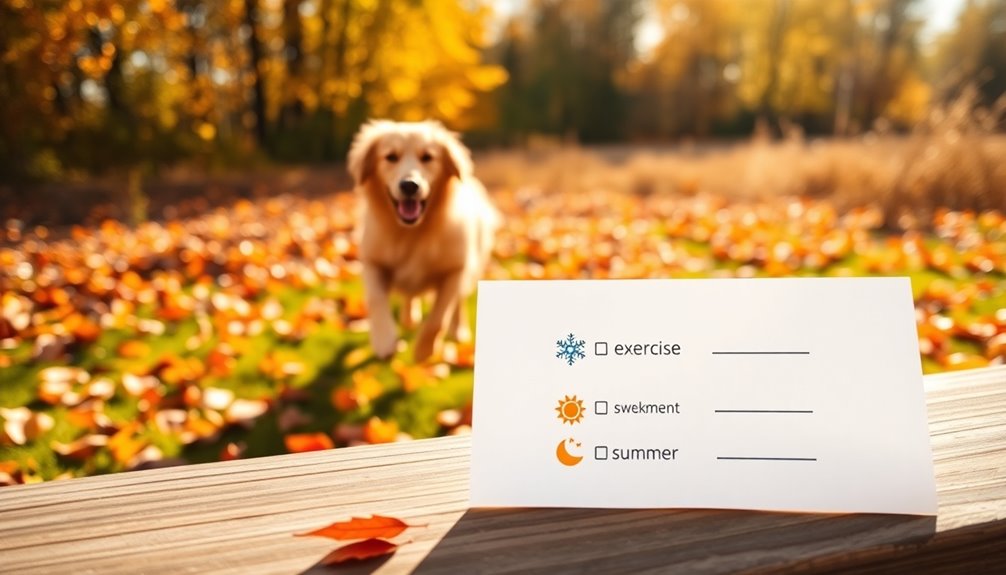
As the seasons change, you'll need to adjust your dog's exercise routine to keep them healthy and happy.
Pay attention to weather conditions, since they can greatly impact how and when you exercise your pet.
Seasonal Activity Adjustments
With each changing season, your dog's exercise routine should adapt to the varying weather conditions and activity levels.
In spring, take advantage of the rising temperatures by focusing on longer walks and outdoor play sessions. This helps your dog shed any winter weight while enjoying the fresh air.
As summer arrives, shift to early morning or late evening activities to prevent heat-related issues, ensuring your pet's health and wellbeing.
When fall comes, engage in hiking and leaf play, benefiting from the cooler weather while keeping your dog active and stimulated.
In winter, modify your exercise routine with more indoor playtime and shorter outdoor walks, as ice and snow can pose hazards to your dog's paws.
Throughout these seasonal changes, it's essential to monitor your dog's behavior and energy levels.
By being attentive, you can tailor the intensity and duration of their exercise to meet their specific needs and health conditions.
Weather Considerations for Exercise
When it comes to exercising your dog, weather conditions play an essential role in guaranteeing their safety and enjoyment. In spring and fall, aim for longer walks and outdoor play sessions during the cooler parts of the day to avoid heat exhaustion, as temperatures can fluctuate considerably.
During the summer months, exercise your dog early in the morning or late in
Mental Stimulation Activities
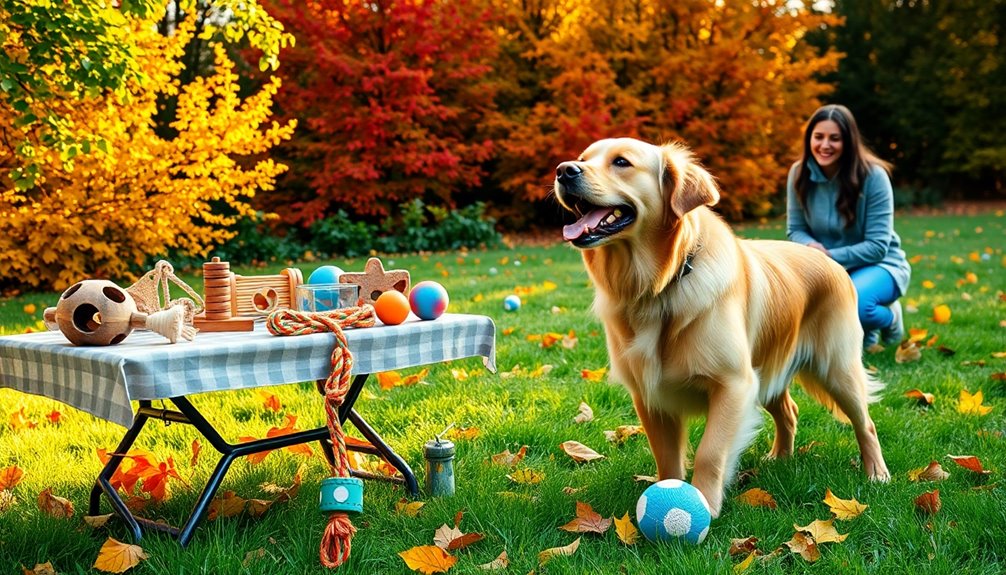
Dogs thrive on mental stimulation just as much as they do on physical exercise. Keeping your furry friend's mind engaged is essential for their overall well-being. Here are some activities you can incorporate into your routine to enhance mental engagement:
| Activity Type | Description |
|---|---|
| Puzzle Toys | Challenge your dog to solve problems and reduce boredom. |
| Interactive Play | Engage in games like hide-and-seek or scent games for fun and exercise. |
| Training Exercises | Teach new commands or tricks to stimulate cognitive function. |
| Sensory Outings | Take your dog to different environments for varied sights and smells. |
Rotating toys and introducing new items can keep your pup intrigued and mentally stimulated. Interactive play sessions not only provide physical exercise but also strengthen your bond. Plus, training exercises improve obedience while sharpening their mental agility. Remember, a well-stimulated dog is a happy dog! Prioritize these mental stimulation activities to combat anxiety and boredom-related behaviors, ensuring your pet remains content and engaged year-round.
Grooming and Hygiene Practices
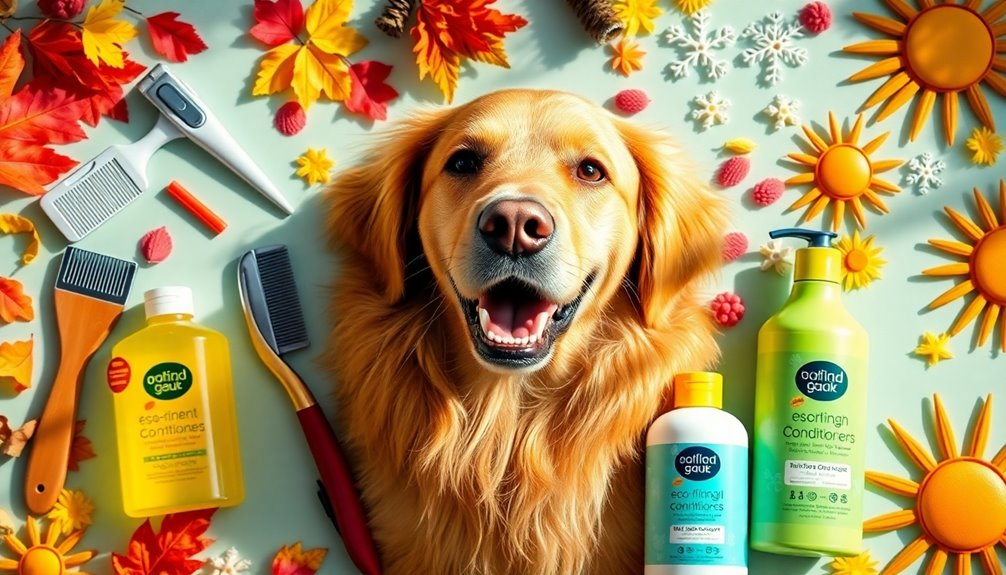
Grooming isn't just about keeping your dog looking good; it's fundamental for their health and happiness. Regular grooming practices like brushing several times a week can prevent matting and reduce shedding, especially during seasonal changes when your pup sheds more fur.
Bathing should typically happen a few times a year, but be certain to remove any mats before washing and rinse thoroughly to avoid soap residue buildup. During warm weather, daily checks for fleas and ticks are essential to prevent infestations and associated health issues.
Nail trimming is another important aspect of grooming that helps avoid gait issues and discomfort. Aim to trim your dog's nails regularly to maintain proper foot health.
Don't forget about ear cleaning! Using veterinarian-approved products can help prevent infections and promote overall hygiene, particularly in breeds prone to ear issues.
Routine Veterinary Checkups
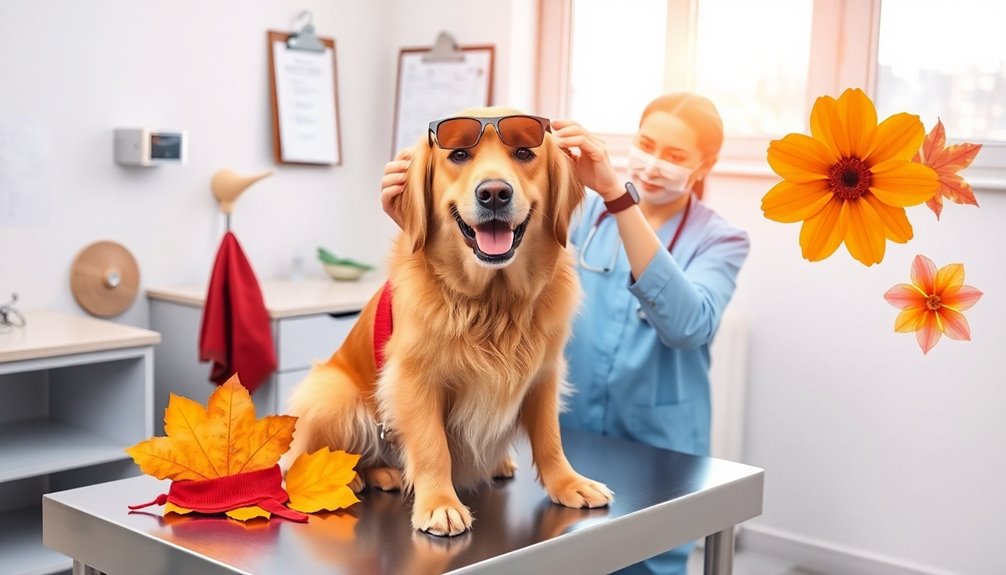
Routine veterinary checkups are essential for your dog's health, helping you catch potential issues before they escalate.
You'll want to keep up with vaccination schedules to protect against serious diseases and guarantee compliance with local laws.
Regular visits also allow for early detection of health problems, so your furry friend can enjoy a long, happy life.
Importance of Regular Checkups
Maintaining your dog's health is fundamental, and regular veterinary checkups play an important role in achieving that. These visits are essential for early detection of health issues, enabling timely intervention that can greatly enhance your dog's quality of life. Aim for thorough examinations at least once a year, or more frequently if your dog is older or has pre-existing conditions.
During these checkups, your vet will assess your dog's weight, coat condition, and key signs, establishing a health baseline for future reference. Regular veterinary checkups also guarantee your dog receives necessary vaccinations, protecting against serious diseases like rabies and parvovirus. This not only safeguards your pet's health but also keeps you compliant with local laws and boarding requirements.
Additionally, these visits are an excellent opportunity to discuss preventive care strategies tailored to your dog's specific needs, such as nutrition, dental health, and exercise plans.
Vaccination Schedules and Updates
When it comes to your dog's health, understanding vaccination schedules and updates is fundamental. Regular annual veterinary check-ups play an important role in monitoring your dog's overall well-being and identifying any health concerns.
For puppies, vaccinations typically start at 6-8 weeks of age, with booster vaccinations administered every 3-4 weeks until they reach around 16 weeks old. These early vaccinations protect them from serious infectious diseases.
As your dog matures into adulthood, they'll need core vaccines such as rabies, distemper, parvovirus, and adenovirus. Your veterinarian will help you determine the best vaccination schedules based on your dog's age, lifestyle, and local regulations.
Adult dogs usually require booster vaccinations every 1-3 years, depending on the specific vaccines they've received.
Maintaining an updated vaccination record is imperative. This record not only guarantees compliance with local laws and boarding requirements but also provides peace of mind when traveling with your pet.
Keeping your dog's vaccinations current is one of the best ways to safeguard their health against various infectious diseases, so make it a priority!
Detecting Health Issues Early
Regular veterinary checkups are essential for keeping your dog healthy and catching potential issues early. For adult dogs, aim for at least one routine veterinary checkup each year, while senior dogs should have exams every six months. These annual exams allow the vet to assess your dog's weight, coat condition, and dental health, helping to identify any abnormalities that might indicate underlying health issues.
During these visits, your vet will also administer regular vaccinations to protect against preventable diseases like rabies, parvovirus, and distemper. By establishing a health baseline during annual exams, you and your veterinarian can better track changes over time and facilitate early intervention when health issues arise.
It's important for you to actively participate in these checkups. Don't hesitate to ask questions and discuss any behavioral changes or symptoms you've noticed. Your observations contribute greatly to your dog's thorough care.
Remember, early detection can make a tremendous difference in managing health problems, allowing for timely treatment and a better quality of life for your furry friend.
Prioritize routine veterinary checkups; they're essential for your dog's long-term health and happiness.
Safety and Emergency Preparedness
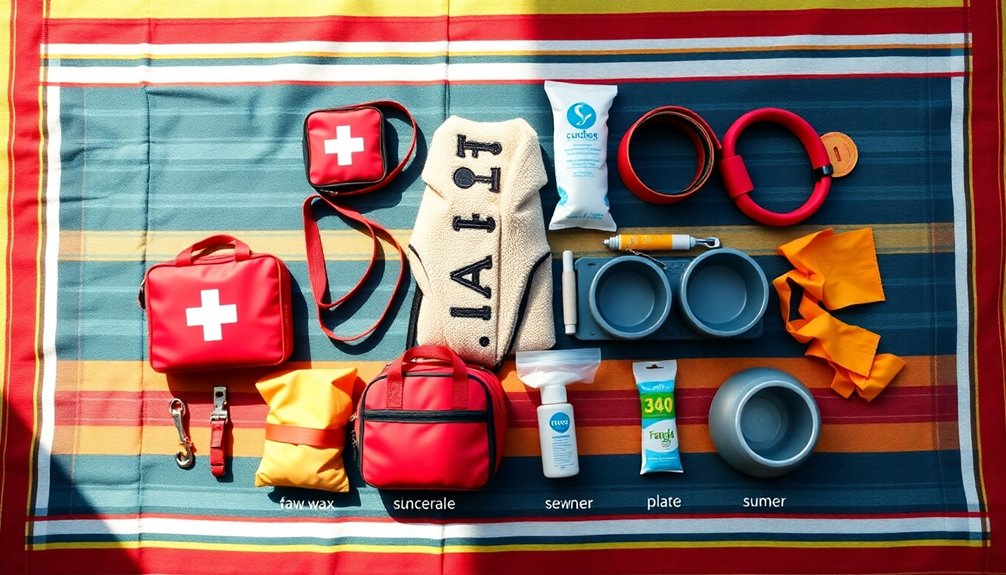
Keeping your dog safe requires proactive measures that can make all the difference in emergencies. Start by pet-proofing your home—secure hazardous items, chemicals, and any choking hazards to prevent accidents. Regularly update your dog's identification, including tags and microchips, making sure they can be easily returned if lost during any season.
Creating a pet emergency kit is essential. Include at least three days' worth of food, water, medications, and first aid supplies tailored to your dog's specific needs. Don't forget to pack essential items like a leash, bowls, and any comfort items your dog loves.
Develop an emergency plan that outlines evacuation routes and a designated caregiver who's familiar with your pet's routine and medical requirements. Practice this plan regularly to guarantee everyone knows their role.
Lastly, keep important documents, such as health histories and vaccination records, easily accessible. This will facilitate prompt care during emergencies, giving both you and your dog peace of mind.
Taking these steps can greatly enhance your dog's safety, preparing you for unexpected situations and helping you manage any challenges that arise.
Frequently Asked Questions
How Can I Tell if My Dog Is Overweight?
To tell if your dog is overweight, you should start by feeling their ribs. You should be able to feel them without excessive pressure.
Also, check their waist; when viewed from above, it should taper in.
If your dog has difficulty exercising or is less active than usual, that's another sign.
Regular vet check-ups can help monitor their weight, so don't hesitate to consult your vet for personalized advice and tips!
What Common Seasonal Hazards Should I Watch For?
When it comes to seasonal hazards for your dog, you need to be vigilant.
In spring, watch for pollen allergies, while summer heat can lead to overheating.
Fall brings the risk of mushrooms and toxic plants, and winter may expose your dog to ice and salt.
Always keep an eye on their behavior and surroundings, and don't hesitate to consult your vet if you notice any unusual symptoms or concerns.
How Often Should I Change My Dog's Food?
You should change your dog's food based on their age, health, and dietary needs.
Generally, it's best to reevaluate their diet every 6 to 12 months. Pay attention to any changes in their weight, energy levels, or digestion. If you notice any issues, consult your vet for tailored advice.
Switching foods should be gradual, mixing old and new to avoid stomach upset. Always prioritize your dog's health and well-being when making changes.
Is It Safe to Bathe My Dog in Winter?
Did you know that around 40% of dog owners skip bathing their pets during winter?
It's safe to bathe your dog in winter, but you should take precautions. Use lukewarm water, and guarantee your dog is thoroughly dried afterward to prevent them from getting cold.
Keep baths infrequent unless your dog gets dirty, and consider using a dog-specific conditioner to maintain their coat's health.
Your pup will appreciate the care!
What Signs Indicate My Dog Needs More Mental Stimulation?
If your dog seems bored, restless, or starts engaging in destructive behaviors, it's a clear sign they need more mental stimulation.
Watch for excessive barking, pacing, or a lack of interest in toys. You might notice them seeking out unusual activities or trying to escape the yard.
Engaging in interactive games, puzzle toys, or training sessions can help keep their mind sharp and satisfied, enhancing their overall well-being and happiness.
Conclusion
Taking care of your dog year-round doesn't have to be overwhelming. By following this ultimate checklist, you'll guarantee your furry friend stays healthy, happy, and safe through every season. Don't forget, a well-cared-for dog brings joy to your life—what could be better than that? So, embrace these tips and watch your pup thrive, knowing you're giving them the love and attention they deserve every day of the year!


